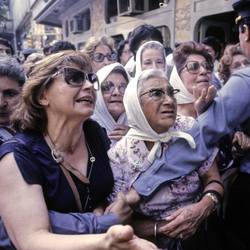“The Vatican Knew What Had Happened to Argentinean Desaparecidos”
Vatican Insider
“The Holy See knew.” During the dictatorship years, an undetermined number of people “disappeared” at the hands of the armed forces. Estimates range from the 7,000-8,000 estimated by Videla - the dictator himself - to the nearly 30,000 claimed by various humanitarian organizations. Before the 1978 World Cup, the Argentine Conference of Bishops informed the Vatican of what was going on in the country: repression, murders, and disappearances. In his article in Argentine newspaper Pagina/12, Horacio Verbitsky writes that a “secret document” was sent to Paul VI by Argentine bishops. The document which dates back to April 1978, refers to meetings between Bishops Raul Primatesta, Juan Carlos Aramburu, and Vicente Zazpe and dictator Jorge Videla. The document says that the issue of the desaparecidos or missing individuals, was openly raised during these meetings (which the clergy say were “cordial and sincere”), and that the bishops also asked where the dead were located. The bishops said that in many cases, the government could not give “a satisfactory answer,” despite the fact that Bishop Primatesta insisted “the Church wants to understand and cooperate” with the State. Videla himself said on several occasions that he had “an excellent relationship - very friendly, honest, and open” with the Catholic Church. It was only in 1996, thirteen years after the end of the military dictatorship, that the Catholic Episcopate carried out an examination of conscience (through the Conference of Bishops) in which they admitted certain errors and took some responsibility. But in general, these examinations vindicate the method of on-going dialogue that Church authorities maintained with the military. In their testimony, both victims and executioners have spoken of the Catholic Church’s role in the extermination of hundreds of people during the dictatorship. In 1976, journalist Jacobo Timerman, during a lunch with a close associate of the Head of the Navy, Emilio Massera, said: “It would be better to introduce martial law, and sentence defendants to the death penalty only after they receive a regular trial.” “But,” Massera’s colleague said, “then the Pope would intervene, and it would be difficult to continue with the executions.” Many years later, General Ramon Genaro Diaz Bessone, theorist of so-called counter-revolutionary war, admitted in a book that political opponents were secretly kidnapped and killed during the dictatorship, without introducing martial law, for fear of the Vatican’s reaction: “Think of the chaos that the Pope unleashed against Francisco Franco in 1975 when he shot three people. It would have been pandemonium. You cannot just shoot seven thousand people.” Diaz Bessone was alluding to the fact that, in 1975, Spanish dictator Francisco Franco – who by then was falling from power – had used the death penalty against political opponents, despite worldwide condemnation (including from Pope Paul VI). But the situation was different in Spain – that was a true civil war, where Franco’s opponents, the Republicans, also shot many nationalists, including hundreds of priests. The situation in Argentina,however, was not a war fought between two groups of armed opponents, but a social engineering operation that extended far beyond political positions. It relied on an ideological and dogmatic apparatus - and the rhetoric of a crusade. Cardinal Raul Francisco Primatesta once said that he was not a prophet of doom, but that action was needed, not just words. “The remedy could be difficult, because the left hand of God, they say it is the Father, but it can be very painful.” (“Left” here is being used to indicate the repression, kidnapping, torture, and secret killing of opponents.) An uproar was recently caused by the publication of a survey by members of the military who say they ended up regretting the disappearances. Most shocking was the testimony of Commander Adolfo Scilingo, who, during the dictatorship, had thrown thirty living people into the sea from a plane (they had been seized and tortured at the Navy Mechanics School, the main camp of the Argentine Navy): “The church hierarchy approved of this method, because it was a ‘Christian and non-violent’ way to die.” After his first flight, Scilingo was wracked by guilt, but the military chaplain calmed him by citing the Biblical parable about separating the wheat from the chaff. Even worse, says Estela Carlotto, President of the Plaza de Mayo Association: “We suffered with our bodies for the Church’s complicity with Argentina’s military dictatorship. Except for a few bishops (4 or 5 that have always helped us, along with the base of the Church), the Argentine Church was very conservative. They knew what was going on, but chose to ignore it, said nothing, and failed to defend the victims. Today the Argentine Church is more progressive, and there is a kind of recognition of human rights violations. These chapters from the past have not been closed, as no one knows what happened to the disappeared, so we want the Church to give a clear response to Argentine society.” The actions of the Catholic Church - especially those of a large part of its hierarchy - have not been sufficiently explained. Several bishops and various military chaplains are suspected of complicity with the dictatorship. Many prisoners who managed to survive the torture and concentration camps denounced the fact that military chaplains ministered to the torturers, even indirectly cooperating with interrogators by trying to break the prisoners’ resistance. In all cases, those who behaved this way justified themselves by saying they were cooperating in the defence of “Catholicism” and the defeat of “communism” because, according to the military, all prisoners were communists.
|
.
Any original material on these pages is copyright © BishopAccountability.org 2004. Reproduce freely with attribution.
